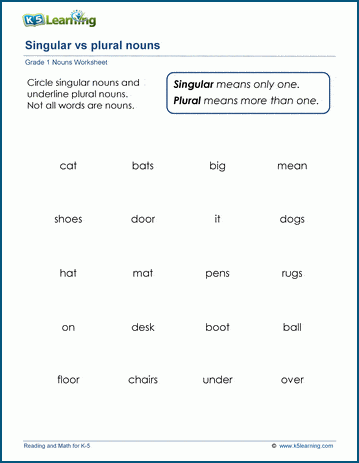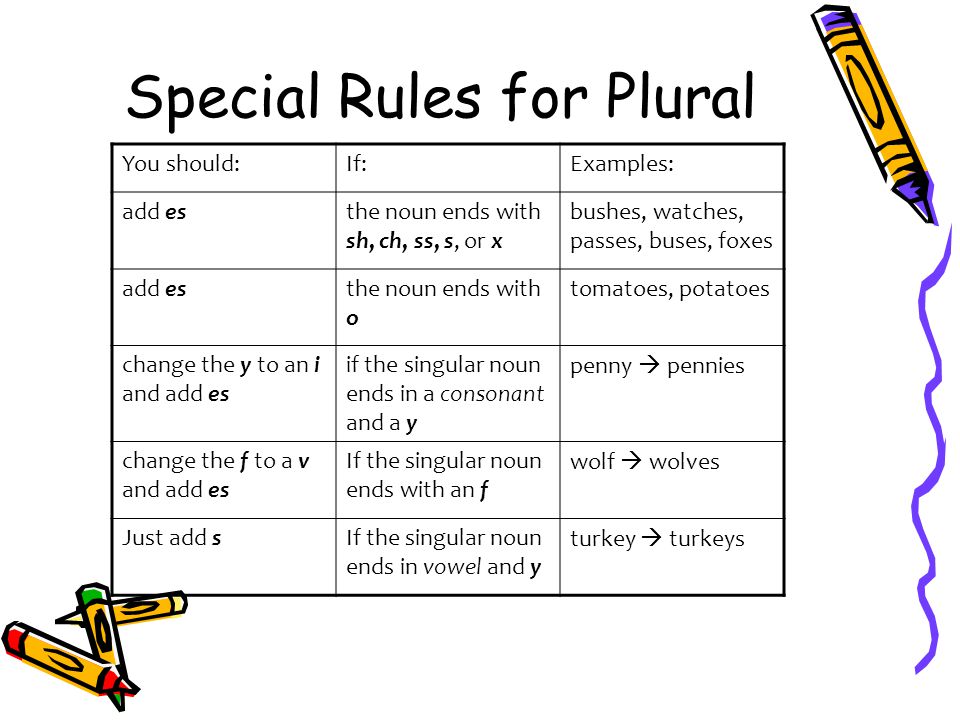Singular And Plural Noun | It has to 'agree' with the noun. Every word is a part of speech and has a role in our language. A singular form and a plural form. When a noun indicates one only, it is a singular noun. In sentences, the verb changes for singular or plural nouns.
Trees, cats, flowers, girls, boys etc. Learn more about singular and plural nouns 1. Every word is a part of speech and has a role in our language. This lesson discusses the variety of ways in which english plural nouns are formed from the corresponding singular forms, as well as various issues concerning the usage of singulars and plurals in english. The difference between singular and plural nouns is easy to see.

They are not used in the singular, or they have a different meaning in the singular. Plural nouns are words used to indicate that there is more than one person, animal, place, thing, or idea. The plural form denotes two or more of something. When a noun is singular, it means there is one of them. However, there are many irregular nouns that add es. Rules for forming plurals explained in simple language and worksheets for beginner, intermediate and advance level learners. Singular and plural nouns and how they're taught in primary school, plus how ks1 and ks2 children learn about the formation of irregular plurals and how to use what are singular and plural? When making the plural form of a noun, usually we. A singular form and a plural form. Nouns used only in the singular. The names of academic subjects such as classics, economics, mathematics/maths, physics; Unfortunately, there are no good rules for knowing if a collective noun should be used as a singular noun or a plural noun. You need to know if the noun is singular or plural when you write a sentence.
A noun names person, place, thing, feeling, idea, or any concept. Some are used as singular nouns, and some are used as plural nouns. • the general plurals rule: Singular nouns and plural noun, learn singular countable nouns and the different spellings for plural nouns, with some nouns that end in y, we form the plural by changing the y to i, and adding es, if there is a vowel before the y (ay, ey, oy), we just add s to form the plural. The diseases measles and mumps;

A singular form and a plural form. For example, the plural of ball is balls. A singular noun refers to one noun, whereas, a plural noun refers to more than one noun. The biggest star of the english language is noun because it names things. Trees, cats, flowers, girls, boys etc. For two or more people, animals, places, or things, a plural noun is used. The plural form denotes two or more of something. All nouns, whether common or proper, can have either a singular or plural form. Usually add the letter s to the end of a singular noun to make it plural. When the thing named is one, we say that the noun has a singular number. Nouns ending with s, ss, z, zz, x, ch, sh, and tch are made plural by adding es to the singular form: Read this article to learn them. In order to make a noun plural, it is usually only necessary to add s.
It has to 'agree' with the noun. Using singular and plural nouns. A singular noun refers to one of something, while a plural refers to more than one of something. A singular noun is a noun that represents a single person, place, thing, or idea. For two or more people, animals, places, or things, a plural noun is used.

It has to 'agree' with the noun. The difference between singular and plural nouns is easy to see. A noun names an object, person or place. In sentences, the verb changes for singular or plural nouns. When a noun indicates one only, it is a singular noun. Nouns ending with s, ss, z, zz, x, ch, sh, and tch are made plural by adding es to the singular form: A singular noun is a noun that represents a single person, place, thing, or idea. A singular noun is used to refer to just one person, animal, thing or place. But there are some rules to take into account. When a noun indicates one person, animal, place, thing, or idea , it is a singular noun. Billiards is played all over the world. Nouns are either in singular or plural form. Unfortunately, there are no good rules for knowing if a collective noun should be used as a singular noun or a plural noun.
A noun names person, place, thing, feeling, idea, or any concept singular and plural. Nouns can be singular and plural.
Singular And Plural Noun: Trees, cats, flowers, girls, boys etc.
Fonte: Singular And Plural Noun
0 Response to "Ostia! 42+ Verità che devi conoscere Singular And Plural Noun? Singular and plural nouns and how they're taught in primary school, plus how ks1 and ks2 children learn about the formation of irregular plurals and how to use what are singular and plural?"
Posting Komentar